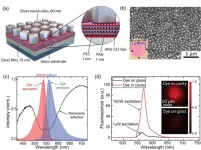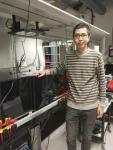(Press-News.org) It is no secret that U.S. politics is polarized. An experiment conducted by MIT researchers now shows just how deeply political partisanship directly influences people's behavior within online social networks.
Deploying Twitter bots to help examine the online behavior of real people, the researchers found that the likelihood that individuals will follow other accounts on Twitter triples when there appears to be a common partisan bond involved.
"When partisanship is matched, people are three times more likely to follow other accounts back," says MIT professor David Rand, co-author of a new paper detailing the study's results. "That's a really big effect, and clear evidence of how important a role partisanship plays."
The finding helps reveal how likely people are to self-select into partisan "echo chambers" online, long discussed as a basic civic problem exacerbated by social media. But methodologically, the experiment also tackles a basic challenge regarding the study of partisanship and social behavior: Do people who share partisan views associate with each other because of those views, or do they primarily associate for other reasons, with similar political preferences merely being incidental in the process?
The new experiment demonstrates the extent to which political preferences themselves can drive social connectivity.
"This pattern is not based on any preexisting relationships or any other common interests -- the only thing people think they know about these accounts is that they share partisanship, and they were much more likely to want to form relationships with those accounts," says first author Mohsen Mosleh, who is a lecturer at the University of Exeter Business School and a research affiliate at the MIT Sloan School of Management.
The paper, "Shared Partisanship Dramatically Increases Social Tie Formation in a Twitter Field Experiment," appears this week in Proceedings of the National Academy of Sciences. In additional to Rand, who is the Erwin H. Schell Professor at the MIT Sloan School of Management and director of MIT Sloan's Human Cooperation Laboratory and Applied Cooperation Team, the authors are Mosleh; Cameron Martel, a PhD student at MIT Sloan; and Dean Eckles, the Mitsubishi Career Development Professor and an associate professor of marketing at MIT Sloan.
To conduct the experiment, the researchers collected a list of Twitter users who had retweeted either MSNBC or Fox News tweets, and then examined their last 3,200 tweets to see how much information those people shared from left-leaning or right-leaning websites. From the initial list, the scholars then constructed a final roster of
842 Twitter accounts, evenly distributed across the two major parties.
At the same time, the researchers created a set of eight clearly partisan bots -- fake accounts with the appearance of being politically minded individuals. The bots were split by party and varied in intensity of political expression. The researchers randomly selected one of the bots to follow each of the 842 real users on Twitter. Then they examined which real-life Twitter users followed the politically aligned bots back, and observed the distinctly partisan pattern that emerged.
Overall, the real Twitter users in the experiment would follow back about 15 percent of Twitter bots with whom they shared partisan views, regardless of the intensity of political expression in the bot accounts. By contrast, the real-life Twitter users would only follow back about 5 percent of accounts that appeared to support the opposing party.
Among other things, the study found a partisan symmetry in the user behavior they observed: People from the two major U.S. parties were equally likely to follow accounts back on the basis of partisan identification.
"There was no difference between Democrats and Republicans in this, in that Democrats were just as likely to have preferential tie formation as Republicans," says Rand.
The bot accounts used in this experiment were not recommended by Twitter as accounts that users might want to follow, indicating that the tendency to follow other partisans happens independently of the account-recommendation algorithms that social networks use.
"What this suggests is the lack of cross-partisan relationships on social media isn't only the consequence of algorithms," Rand says. "There are basic psychological predispositions involved."
At the same time, Rand notes, the findings do suggest that if social media companies want to increase cross-partisan civic interaction, they could try to engineer more of those kinds of interactions.
"If you want to foster cross-partisan social relationships, you don't just need the friend suggestion algorithm to be neutral. You would need the friend suggestion algorithms to actively counter these psychological predispositions," Rand says, although he also notes that whether cross-partisan social ties actually reduce political polarization is unclear based on current research.
Therefore, the behavior of social media users who form connections across party lines is an important subject for future studies and experiments, Mosleh suggests. He also points out that this experimental approach could be used to study a wide range of biases in the formation of social relationships beyond partisanship, such as race, gender, or age.
INFORMATION:
Support for the project was provided, in part, by the William and Flora Hewlett Foundation, the Reset project of Luminate, and the Ethics and Governance of Artificial Intelligence Initiative.
Written by Peter Dizikes, MIT News Office
Additional background
Paper: Shared partisanship dramatically increases social tie formation in a Twitter field experiment
https://www.pnas.org/content/118/7/e2022761118
A new largescale genetic analysis has found biological mechanisms that contribute to making people more susceptible to muscle weakness in later life, finding that diseases such as osteoarthritis and diabetes may play a large role in susceptibility.
As we get older we lose muscle strength, and in some people this severe weakness impacts their ability to live everyday lives, a condition called sarcopenia. Around 10 per cent of people over 50 experience sarcopenia. Many causes thought to impact likelihood of developing this weakness, which is linked to higher death rates.
In a genetic analysis of over 250,000 people aged over 60 from UK Biobank and 21 other cohorts, an international team led by researchers at the University of Exeter ...
WASHINGTON -- Researchers have created a new plasmonic metasurface that achieves record high light efficiency over the entire centimeter-scale metasurface. The advance makes the new nanostructured thin film practical for use in a variety of applications from light-based communication to fluorescence-based biosensing.
"The major obstacles for using plasmonic structures for practical applications is that they are either too inefficient or their nanoscale properties aren't easily scalable to larger sizes," said research team leader Maiken H. Mikkelsen from Duke University. "We designed ...
DURHAM, N.C. - Visible and infrared light can carry more data than radio waves, but has always been confined to a hard-wired, fiber-optic cable. Working with Facebook's Connectivity Lab, a Duke research team has now made a major advance toward the dream of ditching the fiber in fiber optics.
While working to create a free-space optical communication system for high-speed wireless internet, the researchers also show that speed and efficiency properties previously demonstrated on tiny, single-unit plasmonic antennas can also be achieved on larger, centimeter-scale devices.
The research appears online Feb. 11 in the journal Optica.
In 2016, researchers from Internet.org's Connectivity Lab--a subsidiary of Facebook--outlined a new type of light detector that could ...
A total of 1.1 million bitcoin were stolen in the 2013-2017 period. Given the current price for Bitcoin exceeding $40,000, the corresponding monetary equivalent of losses is more than $44 billion highlighting the societal impact of this criminal activity. The question arises how does the uncertainty in the Bitcoin market - measured by its volatility - respond to such cyberattacks.
A recently published research article from Dr. Klaus Grobys (University of Vaasa, Finland) in the well-known journal Quantitative Finance addresses this question.
In his study, he examined 29 hacking incidents that occurred in the Bitcoin market in the 2013-2017 period. A surprising result of this study is that Bitcoin volatility does not respond to hackings with a subsequent ...
Research from the University of Kent, Goethe-University in Frankfurt am Main, and the Philipps-University in Marburg has provided crucial insights into the biological composition of SARS-CoV-2, the cause of COVID-19, revealing vital clues for the discovery of antiviral drugs.
Researchers compared SARS-CoV-2 and the closely related virus SARS-CoV, the cause of the 2002/03 SARS outbreak. Despite being 80% biologically identical, the viruses differ in crucial properties. SARS-CoV-2 is more contagious and less deadly, with a fatality rate of 2% compared to SARS-CoV's 10%. Moreover, SARS-CoV-2 can be spread by asymptomatic individuals, whereas SARS-CoV was only transmitted by those who were already ill.
Most functions in cells are carried ...
A team of researchers studying the effectiveness of different types of face masks has found that in order to provide the best protection against COVID-19, the fit of a mask is as important, or more important, than the material it is made of.
The researchers, from the University of Cambridge, carried out a series of different fit tests, and found that when a high-performance mask - such as an N95, KN95 or FFP2 mask - is not properly fitted, it performs no better than a cloth mask. Minor differences in facial features, such as the amount of fat under the skin, make significant differences in how well a mask fits.
The results, published in the journal PLoS ONE, also suggest that the fit-check routine used in many healthcare settings has high failure rates, as minor leaks ...
Current electronic components in computers, mobile phones and many other devices are based on microstructured silicon carriers. However, this technology has almost reached its physical limits and the smallest possible structure sizes.
Two-dimensional (2D) materials are therefore being intensively researched. One can imagine these materials as extremely thin films consisting of only one layer of atoms. The best known is graphene, an atomically thin layer of graphite. For its discovery, Andre Geim and Konstantin Novoselov received the Nobel Prize in Physics in 2010.
While ...
Our world needs reliable telecommunications more than ever before. However, classic devices have limitations in terms of size and cost and, especially, power consumption - which is directly related to greenhouse emissions. Graphene could change this and transform the future of broadband. Now, Graphene Flagship researchers have devised a wafer-scale fabrication technology that, thanks to predetermined graphene single-crystal templates, allows for integration into silicon wafers, enabling automation and paving the way to large scale production.
This work, published in the prestigious journal ACS Nano, is a great example of a collaboration fostered by the ...
During the first confinement (18 March to 10 May 2020), people who reported worse sleep quality during a night also reported an increase in negative mood, psychotic-type like experiences and somatic complaints on the next day. Furthermore, daily reports of deaths caused by Covid-19 predicted psychological symptoms on the same day and sleep quality the following night. This is the result of research carried out in three countries (Belgium, Hungary, Spain) under direction of Peter Simor with researchers at the Université libre de Bruxelles (ULB), Rebeca Sifuentes-Ortega, Ariadna Albajara Saenz, Oumaïma Benkirane, Anke Van Roy and Philippe Peigneux from the CRCN (Center for Research in Cognition and Neurosciences) and the UNI (ULB Neurosciences Institute) ...
Personality traits such as conscientiousness or sociability are patterns of experience and behavior that can change throughout our lives. Individual changes usually take place slowly as people gradually adapt to the demands of society and their environment. However, it is unclear whether certain personality traits can also be psychologically influenced in a short-term and targeted manner.
Researchers from the universities of Zurich, St. Gallen, Brandeis, Illinois, and ETH Zurich have now investigated this question using a digital intervention. In their study, around 1,500 participants were provided with a specially developed smartphone app for three months and the researchers then assessed whether and ...




